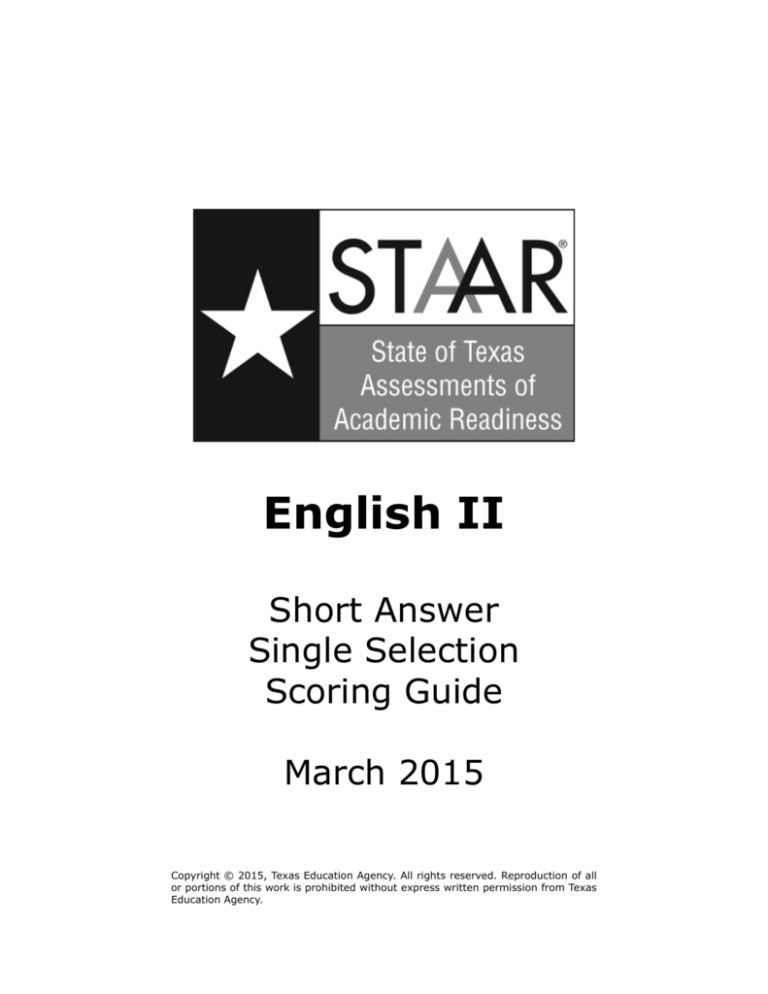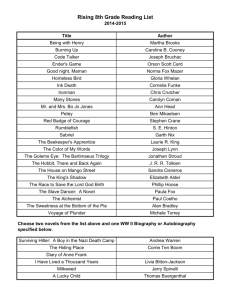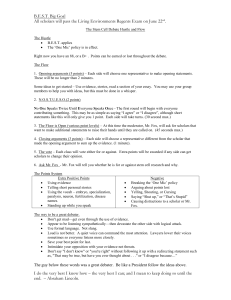
English II
Short Answer
Single Selection
Scoring Guide
March 2015
Copyright © 2015, Texas Education Agency. All rights reserved. Reproduction of all
or portions of this work is prohibited without express written permission from Texas
Education Agency.
Read the selection and choose the best answer to each question. Then fill
in the answer on your answer document.
The Fox
© iStockphoto.com/Christian Riedel
by Faith Shearin
It was an ordinary morning: November, thin light,
and we paused over our pancakes to watch
something red move outside. Our house is on
5
an untamed patch of land and, across the lagoon,
another house surrounded by trees. On the banks
of their shore, facing us: a fox. We thought
he might be a dog at first for he trotted and sniffed
like a dog but when he turned to us
we knew he was nobody’s pet. His face was arranged
10
15
like a child’s face—playful, dainty—and his eyes
were liquid and wild. He stood for awhile, looking out,
as if he could see us in our pajamas, then found
a patch of sand beneath a tree and turned himself
into a circle of fur: his head tucked into his tail.
It was awful to watch him sleep: exposed,
tiny, his eyes closed. How can any animal
be safe enough to rest? But while I washed
our dishes he woke again, yawned, and ran
20
away to the places only foxes know. My God
I was tired of being a person. Even now his tail
gestures to me across the disapproving lagoon.
“The Fox” by Faith Shearin, from MOVING THE PIANO, Stephen F. Austin Press, 2011. Used by permission.
English II Short Answer
Single Selection
In “The Fox,” how would you describe the speaker’s attitude toward the fox?
Support your answer with evidence from the selection.
STAAR English II
Single Selection
Score Point 0 — Insufficient Response to the Question
Insufficient responses indicate a very limited reading performance.
These responses have one of the following problems.
The idea is not an answer to the question asked.
The idea is incorrect because it is not based on the text.
The idea is too general, vague, or unclear to determine whether it is
reasonable.
No idea is present. Sometimes the response contains only text evidence. At
other times there appears to be an idea; however, this idea cannot be
considered an answer to the question because it merely repeats verbatim, or
“echoes,” the text evidence.
Texas Education Agency
Student Assessment Division
March 2015
STAAR English II
March 2015
Single — 1
Score Point 0
The student does not present a reasonable idea. First, the student offers the vague idea that
the speaker has a kind, open-minded attitude toward the fox. The student then provides
additional ideas, one of which is not based on the poem (“she could have been rude at times”)
and others that are too unclear to determine whether they are even linked to the poem (e.g.,
“other times just whatever”). The absence of a reasonable idea causes the response to be
insufficient.
Single — 2
Score Point 0
This response is insufficient because it does not answer the question asked. The student
describes the fox’s freedom and its behavior rather than the speaker’s attitude toward the fox.
STAAR English II
March 2015
Single — 3
Score Point 0
This response is insufficient because the student presents an idea that is incorrect. The idea that
“the speaker’s attitude toward the fox is hatred, disapproval because he/she cannot do what
they want” cannot be supported with evidence from the poem. Because the idea is incorrect,
the direct quotation the student provides is irrelevant.
Single — 4
Score Point 0
This response is insufficient because it lacks an idea. The student restates the question with
the statement “The author’s attitude toward the fox is...” and then provides textual evidence in
the form of a direct quotation, but the student does not offer any description of the speaker’s
attitude toward the fox. For this reason, the student’s reading performance is very limited.
STAAR English II
Single Selection
Score Point 1 — Partially Sufficient Response to the
Question
Partially sufficient responses indicate a basic reading performance.
These responses have one of the following characteristics.
The idea is reasonable, but the response contains no text evidence.
The idea is reasonable, but the text evidence is flawed and does not
adequately support the idea. Text evidence is considered inadequate when it
is
only a general reference to the text,
too partial to support the idea,
weakly linked to the idea, or
used inappropriately because it wrongly manipulates the meaning of the
text.
The idea needs more explanation or specificity even though it is supported
with text evidence.
The idea represents only a literal reading of the text, with or without text
evidence.
Texas Education Agency
Student Assessment Division
March 2015
STAAR English II
March 2015
Single — 5
Score Point 1
In this partially sufficient response, the student presents the reasonable idea that the speaker
is jealous of the fox. The student attempts to provide relevant textual evidence by referring to
the last stanza (“the speaker is wanting to connect with nature like a fox”), but this evidence is
flawed because it functions only as a general text reference and does not sufficiently support
the idea presented. Therefore, this response indicates a basic reading performance.
Single — 6
Score Point 1
The student offers two reasonable ideas: the speaker admires the fox and cares for it. However,
the student does not provide textual evidence from the poem to support these ideas. For this
reason, the response represents a basic reading performance.
STAAR English II
March 2015
Single — 7
Score Point 1
In this partially sufficient response, the student offers the reasonable idea that the speaker is envious of the fox.
The student strengthens this idea by contrasting the fox’s childlike freedom with the limits and responsibilities
the speaker feels in her own life. Although the student attempts to support the idea with direct quotations
from the poem, this textual evidence is too partial to support the explanation. The student’s use of ellipses
omits the relevant portion of the quotation (the comparison of the fox’s face to a child’s face), which is needed
to support the idea that the speaker is envious.
Single — 8
Score Point 1
This response is partially sufficient because the student’s idea represents a literal reading of the poem. While
it is true that the speaker of the poem demonstrates some curiosity about the fox’s actions, the student does
not connect this temporary curiosity to the speaker’s feelings, or attitude, toward the fox. In addition, this
response indicates only a partial understanding of the poem since the student interprets the question “How
can any animal be safe enough to rest?” as a simple question of curiosity rather than the speaker’s search for
a deeper understanding. Therefore, this response indicates a basic reading performance.
STAAR English II
Single Selection
Score Point 2 — Sufficient Response to the Question
Sufficient responses indicate a satisfactory reading performanc
e.
These responses have the following characteristics.
The idea is reasonable and goes beyond a literal reading of the text. It is
explained specifically enough to show that the student can make appropriate
connections across the text and draw valid conclusions.
The text evidence used to support the idea is accurate and relevant.
The idea and text evidence used to support it are clearly linked.
The combination of the idea and the text evidence demonstrates a good
understanding of the text.
Texas Education Agency
Student Assessment Division
March 2015
STAAR English II
March 2015
Single — 9
Score Point 2
The student offers the reasonable idea that the speaker’s positive attitude toward the fox is
evident through her use of language. To support this idea, the student points out the diction
the speaker uses to describe the fox (“playful” and “dainty”) as well as the simile the speaker
uses to characterize the fox as innocent (“like a child’s face”). The idea and textual evidence
are clearly linked and show that the student has a good understanding of the poem.
Single — 10
Score Point 2
The student presents the reasonable idea that the speaker is amazed by the fox’s vulnerability.
The student supports this idea with clearly linked direct quotations that illustrate the speaker’s
awareness of how vulnerable the fox is and how worried she is as she watches it sleep. The
combination of the idea and textual evidence indicates that the student’s reading performance
is satisfactory.
STAAR English II
March 2015
Single — 11
Score Point 2
The student offers the reasonable idea that the speaker yearns to be free like the fox. The
student uses a paraphrase of lines 16–17 (“while I washed/our dishes”) to establish that this
yearning takes place in the context of completing a daily chore. The direct quotation the
student provides as support underscores the speaker’s strong desire to escape her everyday
responsibilities. Overall, the student’s response to the question is sufficient.
Single — 12
Score Point 2
The student presents several reasonable ideas that demonstrate the ability to draw valid
conclusions: the speaker admires the fox, shows concern for it, and envies it. The student
paraphrases parts of lines 11–20 to support these ideas. The ideas and textual evidence are
clearly linked, indicating a satisfactory reading performance.
STAAR English II
Single Selection
Score Point 3 — Exemplary Response to the Question
Exemplary responses indicate an accomplished reading performance.
These responses have the following characteristics.
The idea is perceptive and reflects an awareness of the complexities of the
text. The student is able to develop a coherent explanation of the idea by
making discerning connections across the text.
The text evidence used to support the idea is specific and well chosen.
Overall, the evidence strongly supports the validity of the idea.
The combination of the idea and the text evidence demonstrates a deep
understanding of the text.
Texas Education Agency
Student Assessment Division
March 2015
STAAR English II
March 2015
Single — 13
Score Point 3
In this exemplary response, the student presents the reasonable idea that the speaker is jealous of the fox’s
freedom. The student further explains this idea by contrasting the speaker’s burdens and responsibilities
with the fox’s freedom to do what it wants. This explanation shows that the student can make discerning
connections. In addition, the direct quotations the student uses are well chosen and strongly support the idea
and explanation. Overall, this response demonstrates that the student has a deep understanding of the poem.
Single — 14
Score Point 3
The student develops a coherent analysis of why the speaker is envious of the fox’s freedom. The student
analyzes the speaker’s jealousy by focusing on her use of descriptive language to contrast the sense of safety
and trust the sleeping fox exudes with her own feelings of vulnerability. The speaker can watch but not
experience the freedom the fox has because, unlike the fox, she is not free to let her guard down. The student
uses a specific, well-chosen direct quotation to support the validity of the idea. The combination of perceptive
analysis and strong textual evidence indicates an accomplished reading performance.
STAAR English II
March 2015
Single — 15
Score Point 3
The student offers a coherent explanation of how the speaker’s tone reveals the depth of her admiration for
the fox and her desire to protect her own freedom, as symbolized by the fox. The student makes discerning
connections across the poem to explain how the speaker’s feelings of protectiveness toward the fox actually
represent her own longing for the “natural freedom he symbolizes.” The student supports the idea with wellchosen direct quotations from the text, demonstrating an accomplished reading performance.
Single — 16
Score Point 3
The student presents the perceptive idea that observing the fox’s freedom causes the speaker to feel wistful and
dissatisfied with her life. The student contrasts the fox’s carefree lifestyle with the speaker’s “stressful, human
life,” noting that the speaker’s wish to escape a tedious life is so strong that even the lagoon “judged her for
staying put.” The direct quotation that student uses is particularly apt, as it strongly supports the speaker’s
overpowering and lingering desire to be free like the fox. The combination of idea, explanation, and textual
evidence demonstrates a deep understanding of the poem.








